Research Point
The Golden Mean
The Golden Mean is a way of measurement used for many years by artists, architects and others to observe landscapes and buildings around us. This mathematical ratio commonly found in nature—the ratio of 1 to 1.618.
The golden ratio is depicted as a single large rectangle formed by a square and another rectangle. What’s unique about this is that you can repeat the sequence infinitely and perfectly within each section see image below:.

Used in art, the golden ratio is the most mysterious of all compositional strategies used. By creating images based on this rectangle our art will be more likely to appeal to the viewer, the mysterious this is that no one knows why
Artists throughout history, like Botticelli and Leonardo daVinci, have used the golden rectangle, or variations of it, as the basis for their compositions.
Da Vinci The Last Supper, with golden sections highlighted.
http://www.goldennumber.net/art-composition-design/
Golden rectangles are still the most visually pleasing rectangles known, and although they’re based on a mathematical ratio, they are not that hard to understand how to use them.
For my own reference below from http://www.goldennumber.net/art-composition-design/
----------------------------------------------------------------------------------------------------------------------------------How to make a rectangle based on the golden ratio
If you want to use a golden rectangle in your own compositions, here’s how you can make that happen without any special tools or mathematical formulas.
1. Begin with a square, which will be the length of the short side of the rectangle.
2. Then draw a line that divides it in half (forming two rectangles).
3. Draw a line going from corner to opposing corner of one of those halves.

4. Rotate the top point of that diagonal line downward until it extends your square.
5. Finish off the rectangle using that diagonal length as a guide for the long side of your golden rectangle. It’s that simple.
Visual points of interest inside a golden rectangle
Any square or rectangle (but especially those based on the golden ratio) contain areas inside it that appeal to us visually as well. Here’s how you find those points:
1. Draw a straight from each bottom corner to its opposite top corner on either side. They will cross in the exact center of the format.
2. From the center to each corner, locate the midway point to each opposing corner.
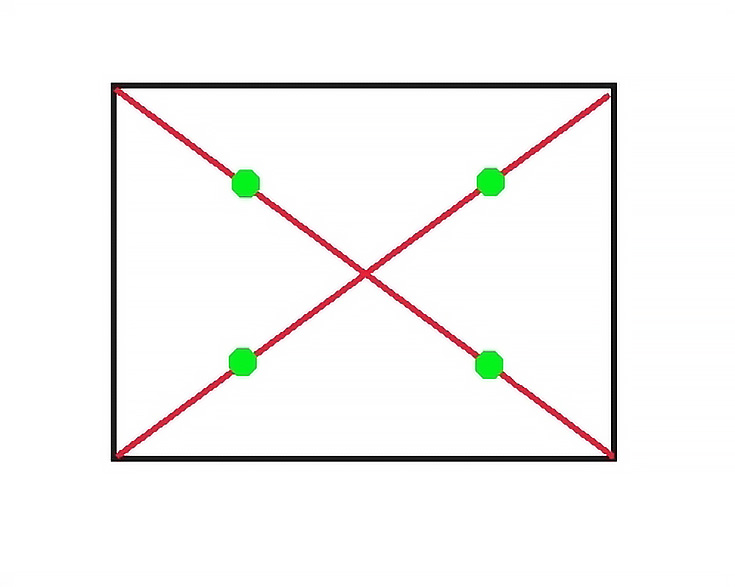
These points—represented by the green dots in the diagram above—are called the “eyes of the rectangle.”
-----------------------------------------------------------------------------------------------
By looking at this information I can see that if a maintained a ratio of small elements to larger elements that was the same as the ratio of larger elements to the whole, the end result will be more pleasing to the eye. Another way to create images more pleasing to the eye is using the 'Rule of Thirds'.
Rule of thirds
The rule of thirds compromises of using as grid such as below:
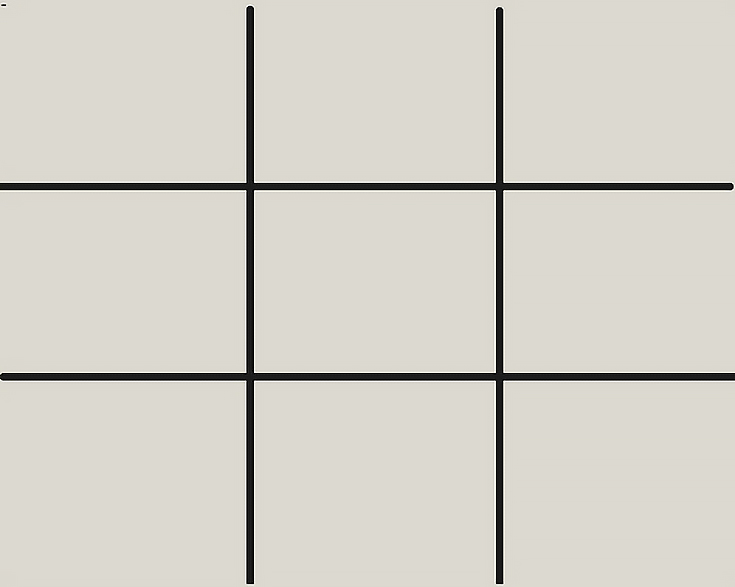
When you look at this grid you can see there are three squares across and three squares up which give the name the rule of thirds. When drawing the grid the 4 points which cross over are key power points which work in a painting to create a better composition. See below for a good example that I found:
http://emptyeasel.com/2009/02/03/the-rule-of-thirds-why-it-works-and-how-to-use-it-in-your-art/
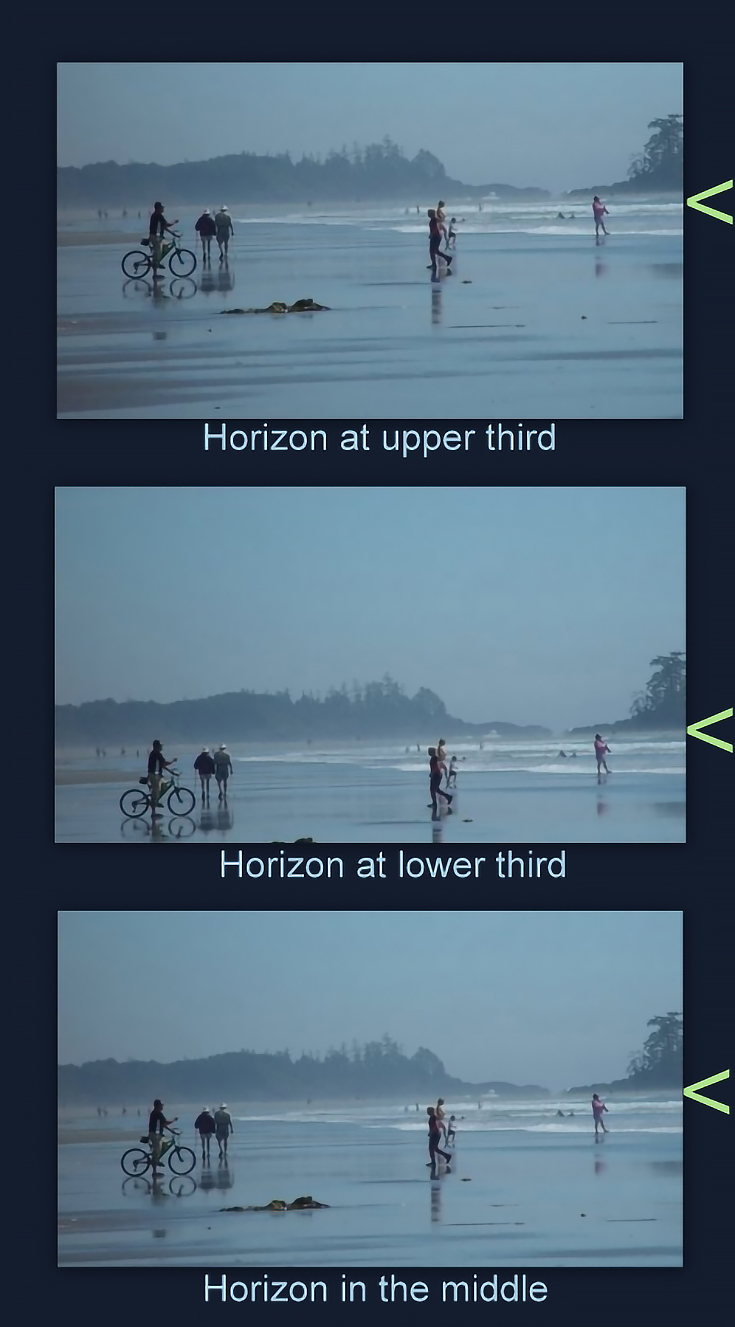
I can notice by looking at this that paintings 1 and 2 have more appeal to me then the bottom one with the landscape horizon in the middle. The other two give the painting more lift to the composition making it different and more appealing to the eye. The top two are more appealing as the artists has put them on the higher and lower levels of the Third Rule grid to achieve a more appealing view.
By researching this I am excited to test these out in my paintings. I am looking forward to finding ways to use this in my sketches and when observing landscapes.
Artist I have found using these two principles
I have had a look on the internet and I have looked at some paintings below which I think the Golden and the Rule of thirds has come in to place:
The Golden Rule
The Golden Rule was used extensively by Leonardo Da Vinci
The Golden Rule
The Golden Rule was used extensively by Leonardo Da Vinci
The last Supper
http://www.goldennumber.net/art-composition-design/
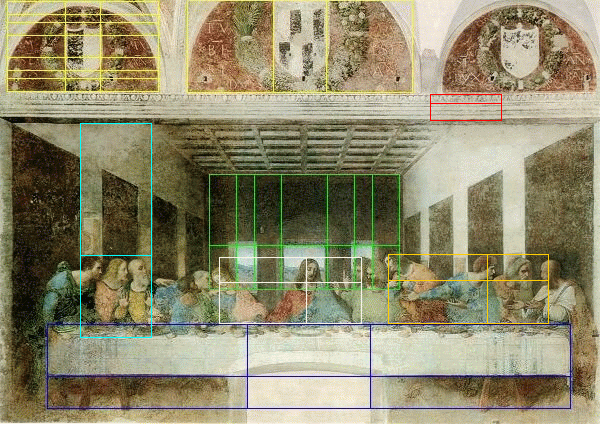
Below Da Vinci “The Annuciation” the golden rule is used on the lines of the brick wall which are of the same proportion.
http://www.goldennumber.net/art-composition-design/
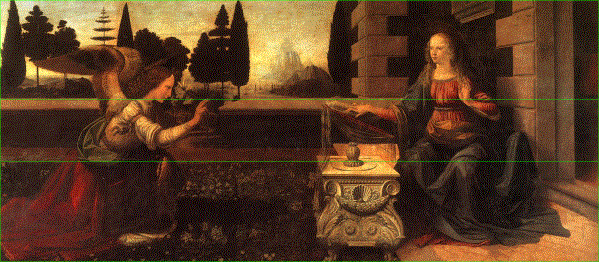
Even the smaller details such as on the table, have been positioned to follow the golden rule:

Michelangelo also used the Golden rule:
“The Creation of Adam” on the ceiling of the Sistene Chapel
http://www.goldennumber.net/art-composition-design/

Rule Of Thirds
The rule of thirds to me, is more understandable and I can see how well it works. I looked at a few Naive paintings below which I can see that the rule of thirds has been used to make there paintings have a better composition.
Rebecca Campbell
3 Chickens Equals 1 Turkey
http://www.redraggallery.co.uk/artist-rebecca-campbell.asp?gId=21

This Painting above has used the rule of thirds by the artist placing the rope on one of the two invisible lines across the page, to create focus on the main area in her painting. Also the rooster on the right is in the area of a power view point of the rule of thirds.

Art by Paul Robinson
Flora Waits with Anticipation
http://www.redraggallery.co.uk/showInventory.asp?iId=13731&title=Flora%20Waits%20with%20Anticipation&artist=Paul%20ROBINSON

In this painting, the rule of thirds is used here which makes the red phone box and Big Ben the main focal points.
Vivienne LUXTON
Celebrating a new Recipe
http://www.redraggallery.co.uk/showInventory.asp?iId=13599&title=Celebrating%20a%20new%20Recipe&artist=Vivienne%20LUXTON

This artist has used the rule of thirds to focus on the two happy chefs. The rule of thirds power areas hit both of there faces in the centre of the painting.
Exercise - Painting a landscape Outside
For this painting I have read the Oca folder in how to prepare for painting outdoors, I have my easel which folds up in to a carry case, which also holds my tools such as paint brushes, Brushes sponges etc. I have decided to use an artist board. I really enjoy using them I have found them to be more easier moving them around then a piece of paper or a canvas which can sometimes be awkward to carry around. The art boards are slim and easy to just take any where. I have an apron, which I will be putting over my coat to keep things clean. I have got a glass that I shall put my turps in when it comes to painting and lots of toilet roll to absorb any turps off brushes or mistakes. I have got my tools to research the area such as water colour paints and pencils to sketch out the area I find and create a few different angled sketches.
11/08/15 First of all I need to decide on an area I would like to paint. I need some where local so I don't have to travel far and I can go there a few times if need be. I am going to go out for a walk and see what I find, Taking my sketch book with me and some tools just in case I'm lucky to find a really interesting area.
I am now writing on my blog from my mobile phone. I think I have found a place to draw, Its an interesting country side area, Part of a farm. I am on a grassy slope looking in to the area. What's really interesting is that there is a old barn to the right of the area and I think could make a good focal point. Also in front of me there is a sign post. I am going to take a photo of my area to show here.
This area is a great idea for a painting as it is not flat and there are interesting parts to my view. by looking at the photo I can see there is a lot of sky and the horizon line is in the middle. To make this more interesting and to use the rule of thirds I am going to crop the image and get rid of some of the sky hopefully this will bring my horizon upwards and then I will know when looking out to the view what areas I am putting in to my painting.
As you can see after cropping the image the area has become even more interesting. To capture the view I intend with less sky and more land I think it is best for me to get lower down to the ground so I am now sitting on the small hill that I was standing on looking in to the farm area.
Sitting here now looking at the view the key features I instantly notice are the Barn on the right in the middle ground on a hill and the sign post on the left which is in the foreground (on the hill I am sitting on). What also interested me in this area is the way the light of the sun reflects on the field in the background, it creates some what of a luminance on the grass where I can see which makes the grass seem to have a yellow tone to it. There is a bridge in the background through the trees. I can see cars going across it. There is two fences in this area which divides up the land scape which creates a good effect to the composition. Lastly there are bushes either side of my view which frame the area nicely. The Mood and atmosphere of the area to me is a very pleasant sunny day with the general mood of happiness with surrounding nature. The atmosphere is of a general countryside.
Where I am sitting is a quiet area with a country road behind me which is a good area to help me concentrate and to avoid the passers by.
Looking at the area I have decided to split the drawing in to three areas the background the middle ground and the foreground. By looking at those areas at a whole then individually I think it will help me to get more of a detailed painting. I have decided I don't want too much sky as there is enough interesting things to look at on the ground. The land moves up in height so it creates a interesting composition. I have decided I think having a vertical view of the landscape will look better then a horizontal landscape. This is because the area/view I want to capture is narrow and putting in on a landscape view it will ruin the composition I want to capture. I know this is a risk but I feel it is going to work out well I want to trust my theory of the way the bushes frame the narrow view I have.
For this painting I am going to use the rule of thirds. I think this will work out really well as the barn is not on a equal level being in the top right area. If I was to draw this area I can see that the barn would be hitting one of the rule of thirds power areas and the sign post is hitting the bottom left power point which make this view a great opportunity to use this rule to create a dramatic composition. I have got my photo below with the rule of thirds grid on just to show how it is going to work.
I am now going to sketch a few angles to get to know the area better and where the correct level of the horizon is going to be. I will look at contrasting tonal areas and paint samples of colours that I can see in the view to use with in the paintings I shall be doing at a later point. I feel the landscape has linear and Aerial qualities. Linear because of the depth in the view due to the fences splitting up the areas and Ariel view due to the trees far out in the background becoming blue due to the atmosphere. I am now going to start and will report back once home.
Sitting here now looking at the view the key features I instantly notice are the Barn on the right in the middle ground on a hill and the sign post on the left which is in the foreground (on the hill I am sitting on). What also interested me in this area is the way the light of the sun reflects on the field in the background, it creates some what of a luminance on the grass where I can see which makes the grass seem to have a yellow tone to it. There is a bridge in the background through the trees. I can see cars going across it. There is two fences in this area which divides up the land scape which creates a good effect to the composition. Lastly there are bushes either side of my view which frame the area nicely. The Mood and atmosphere of the area to me is a very pleasant sunny day with the general mood of happiness with surrounding nature. The atmosphere is of a general countryside.
Where I am sitting is a quiet area with a country road behind me which is a good area to help me concentrate and to avoid the passers by.
Looking at the area I have decided to split the drawing in to three areas the background the middle ground and the foreground. By looking at those areas at a whole then individually I think it will help me to get more of a detailed painting. I have decided I don't want too much sky as there is enough interesting things to look at on the ground. The land moves up in height so it creates a interesting composition. I have decided I think having a vertical view of the landscape will look better then a horizontal landscape. This is because the area/view I want to capture is narrow and putting in on a landscape view it will ruin the composition I want to capture. I know this is a risk but I feel it is going to work out well I want to trust my theory of the way the bushes frame the narrow view I have.
For this painting I am going to use the rule of thirds. I think this will work out really well as the barn is not on a equal level being in the top right area. If I was to draw this area I can see that the barn would be hitting one of the rule of thirds power areas and the sign post is hitting the bottom left power point which make this view a great opportunity to use this rule to create a dramatic composition. I have got my photo below with the rule of thirds grid on just to show how it is going to work.
I am now going to sketch a few angles to get to know the area better and where the correct level of the horizon is going to be. I will look at contrasting tonal areas and paint samples of colours that I can see in the view to use with in the paintings I shall be doing at a later point. I feel the landscape has linear and Aerial qualities. Linear because of the depth in the view due to the fences splitting up the areas and Ariel view due to the trees far out in the background becoming blue due to the atmosphere. I am now going to start and will report back once home.
I am now home and now looking at what I have done in my sketch book . I am very happy with the outcome. I have used the rule of thirds and I feel it is a great composition to use. My sketches were from left and right angles to get to know the area better. I still feel straight on angle sitting down in the best. I painted in water colour in my sketch book the final view I want to paint. I have put details of the objects on my pre drawings as the viewers may not totally understand my quick sketches. I have looked at what colours are best to use. I found my sap green to be of use for the bushes mixed in with different colours: Black to add deep depth in bushes/trees. Whites and yellow to add light and tone. for the ground dirt pathways in my view grey and earth colours will be great for this. My colour choices are below. I aim to keep them restricted and creating a variety by mixing them with other colours:
White, Black, Sap Green, Yellow, Marine Blue and burnt umber.
I arrived there at 3pm and during being there for the last hour and half the light shifted to the right. I want to capture the light how I saw it, when I first arrived where it was reflecting on the field in the background. To help keep the same light, I will refer to the photos I took and also when I begin my painting, I will return to the area about the same time to capture it. It has been a sunny day today and I do want to go out again tomorrow to start painting. Hopefully the weather will be the same.
White, Black, Sap Green, Yellow, Marine Blue and burnt umber.
I arrived there at 3pm and during being there for the last hour and half the light shifted to the right. I want to capture the light how I saw it, when I first arrived where it was reflecting on the field in the background. To help keep the same light, I will refer to the photos I took and also when I begin my painting, I will return to the area about the same time to capture it. It has been a sunny day today and I do want to go out again tomorrow to start painting. Hopefully the weather will be the same.
12/08/15 I have come home today from work and its dull and starting to rain, so I shall try again tomorrow. The is no point in going out today as the atmosphere of the scene wont be the same plus Ill get wet and my painting will get wet too.
13/08/2015 Today the weather is a lot better I am really excited to get started. I have packed my things I need together and I am now ready to set off.
I have now arrived here at 2.45pm hoping to see the light in the same area for a bit longer. I have set my easel up and my blank bored ready to start the first steps towards painting. Whilst checking my sketches and looking at the area again I want to point out that the area still looks the same and I am lucky enough to have the same light there again too. I have drawn my rule of thirds grid on my board and now have just finished sketching the basic areas out. I am now going to start the painting its 3pm. I am going to start with painting in the sky and the trees in the background. Hopefully I will do the field too.
I am now back home and this is what I painted:
Obviously its not finished. I think I will have to make 2 more trips. I have managed to put the sky in with the background detail of the trees. I was lucky enough to have put in the field that is in the background too. I have used yellow with the sap green to capture the light on the field as discussed previously and I think I have painted that area well. I like the trees in the background I added a little black to add depth to them and it gives a realistic effect. The bridge in the background is there also. I will be adding texture on to this once dry. I have also done two black areas either side of the painting which is for the trees/bushes, which frame my scene. I have done them black and once they are dry I will put a green foliage texture on. The black underneath will then create depth in those objects. I have also just added in some of the basic lines where other things will be going in my painting such as the fence, the barn and the hill and the tractor path. I think for my first trip I have managed to do quite a bit. I shall now wait until its dry to go out again and do some more.
15/8/2015 I have today been out again and this is what my painting looks like now:
Today was not as warm and sunny so I had to wrap up a bit. Whilst I was out there it began to rain so could not stay out long. I managed to add the detail on the barn, the bridge in the background, the fence, the hill where the barn is and the tractor path. I like the texture I have got on the grass where the barn in and the way I applied the paint to the dirt track of the tractor path. I did this by using a flat brush and using various greys with yellows and applying dabs of paint to where I saw was necessary, I think it creates a good rough texture to the ground. The hill of grass was interesting to create. With all the colours of the different type of grass together I had to look closely to attain the same colours I could I my painting using my limited pallet. I did this by using my sap green with yellow, grey and white. I am going to attempt again tomorrow to see if I can get back out there.
16/08/2015 I am now back out here its 2.40pm still keeping to around the same time frame. Its a better day today, its back warm and sunny again. I am going to carry on with my painting now and report back here later.
Here is my painting of what I did today:
I managed to finish the trees and bushes either side of my view and place in the fence that is in the foreground. I also did the basic first layer in my foreground on the grassy areas and the hill I am sitting upon. I find the bushes and trees fun to do. I particularly liked the tree on the top right hand side I did small brown strokes for branches then got a small brush to apply small dabs to look like leaves. I used different tones of sap green and for the lightest area of the tree I added white. I did this technique to the other 3 trees/bushes surrounding the painting. The bush at the lower left, weaves through the fence and is over grown, so the fence disappears with-in the bush. I have just applied the basic shape and texture of this bush and will improve it on my next attempt. I think I will only need one more go at this landscape to finish it off.
18/08/2015 I have been out today with my paining and I have finished my land scape:
I worked out that overall it took me about 4.1/2 hours to paint from start to finish, which I don't think is bad. I finished my painting today, by adding the detail to my foreground which was the fence, the grassy border below it, the pathway, the grassy bush on the left, the hill I am sitting on and the Signpost in front of me. Looking at my painting now, I can still confirm it was a good idea to take a risk and do my landscape vertical. Using The Rule of Thirds, helped my painting come together as a insightful composition of the area I was looking at. My technique of how I created textures gives really good detail to my painting. Looking at the painting gives you a sense of depth and a far out view into the distance. I kept to the colours and my ideas and it has paid off. To critique me work however, I think the barn looks too small, or I may have done the middle fence to big, creating a sense of incorrect proportion on these two objects. I think other then that I am happy with what I have achieved and it was a good experience for me.
500 words on the Experience and what I have learned from it:
Before starting this exercise I thought to myself that this would be an easy fun task, to just go outside and paint. Whilst I did have fun, I came to realise there are many things to consider, even before starting a painting as well as during painting. One of the key factors for me was the weather and the time of day in which I painted, to keep my painting with the same atmosphere when I first observed it. I now understand it is difficult in getting the same light and mood of an area as the landscape and weather is constantly changing. I did however take photos which I referred to and I went to the area around at the same time every day, to make sure to capture the suns light in the right place as it was. Taking a chance and going out is another thing I learnt. On one of the days I took a chance and it did rain and I had to quickly hurry home to protect my painting. It was a good experience and I have not been put off doing it again.
I have now arrived here at 2.45pm hoping to see the light in the same area for a bit longer. I have set my easel up and my blank bored ready to start the first steps towards painting. Whilst checking my sketches and looking at the area again I want to point out that the area still looks the same and I am lucky enough to have the same light there again too. I have drawn my rule of thirds grid on my board and now have just finished sketching the basic areas out. I am now going to start the painting its 3pm. I am going to start with painting in the sky and the trees in the background. Hopefully I will do the field too.
I am now back home and this is what I painted:
Obviously its not finished. I think I will have to make 2 more trips. I have managed to put the sky in with the background detail of the trees. I was lucky enough to have put in the field that is in the background too. I have used yellow with the sap green to capture the light on the field as discussed previously and I think I have painted that area well. I like the trees in the background I added a little black to add depth to them and it gives a realistic effect. The bridge in the background is there also. I will be adding texture on to this once dry. I have also done two black areas either side of the painting which is for the trees/bushes, which frame my scene. I have done them black and once they are dry I will put a green foliage texture on. The black underneath will then create depth in those objects. I have also just added in some of the basic lines where other things will be going in my painting such as the fence, the barn and the hill and the tractor path. I think for my first trip I have managed to do quite a bit. I shall now wait until its dry to go out again and do some more.
15/8/2015 I have today been out again and this is what my painting looks like now:
Today was not as warm and sunny so I had to wrap up a bit. Whilst I was out there it began to rain so could not stay out long. I managed to add the detail on the barn, the bridge in the background, the fence, the hill where the barn is and the tractor path. I like the texture I have got on the grass where the barn in and the way I applied the paint to the dirt track of the tractor path. I did this by using a flat brush and using various greys with yellows and applying dabs of paint to where I saw was necessary, I think it creates a good rough texture to the ground. The hill of grass was interesting to create. With all the colours of the different type of grass together I had to look closely to attain the same colours I could I my painting using my limited pallet. I did this by using my sap green with yellow, grey and white. I am going to attempt again tomorrow to see if I can get back out there.
16/08/2015 I am now back out here its 2.40pm still keeping to around the same time frame. Its a better day today, its back warm and sunny again. I am going to carry on with my painting now and report back here later.
Here is my painting of what I did today:
I managed to finish the trees and bushes either side of my view and place in the fence that is in the foreground. I also did the basic first layer in my foreground on the grassy areas and the hill I am sitting upon. I find the bushes and trees fun to do. I particularly liked the tree on the top right hand side I did small brown strokes for branches then got a small brush to apply small dabs to look like leaves. I used different tones of sap green and for the lightest area of the tree I added white. I did this technique to the other 3 trees/bushes surrounding the painting. The bush at the lower left, weaves through the fence and is over grown, so the fence disappears with-in the bush. I have just applied the basic shape and texture of this bush and will improve it on my next attempt. I think I will only need one more go at this landscape to finish it off.
18/08/2015 I have been out today with my paining and I have finished my land scape:
I worked out that overall it took me about 4.1/2 hours to paint from start to finish, which I don't think is bad. I finished my painting today, by adding the detail to my foreground which was the fence, the grassy border below it, the pathway, the grassy bush on the left, the hill I am sitting on and the Signpost in front of me. Looking at my painting now, I can still confirm it was a good idea to take a risk and do my landscape vertical. Using The Rule of Thirds, helped my painting come together as a insightful composition of the area I was looking at. My technique of how I created textures gives really good detail to my painting. Looking at the painting gives you a sense of depth and a far out view into the distance. I kept to the colours and my ideas and it has paid off. To critique me work however, I think the barn looks too small, or I may have done the middle fence to big, creating a sense of incorrect proportion on these two objects. I think other then that I am happy with what I have achieved and it was a good experience for me.
500 words on the Experience and what I have learned from it:
Before starting this exercise I thought to myself that this would be an easy fun task, to just go outside and paint. Whilst I did have fun, I came to realise there are many things to consider, even before starting a painting as well as during painting. One of the key factors for me was the weather and the time of day in which I painted, to keep my painting with the same atmosphere when I first observed it. I now understand it is difficult in getting the same light and mood of an area as the landscape and weather is constantly changing. I did however take photos which I referred to and I went to the area around at the same time every day, to make sure to capture the suns light in the right place as it was. Taking a chance and going out is another thing I learnt. On one of the days I took a chance and it did rain and I had to quickly hurry home to protect my painting. It was a good experience and I have not been put off doing it again.
I think choosing your area is also important to help portray what you want the views to see, such as a story or an atmosphere you like and want to share it with the viewers. I have learnt that you have to work around nature, to get the painting you desire. If there’s a day without the correct weather, then you just have to wait for the next day. Painting outside was eye opener, it made me feel at one with the landscape I was looking at and I had fun capturing the sights and the correct colours of the area. I have learnt to look more in-depth at landscapes to capture what is important to you with in that area.
The main features were placed in my landscape with the help of the ‘The Rule of Thirds’. It really made my composition come together. Deciding on the composition was a good exploration of different views. Sitting down in the end was the best way to capture more of the land and less sky. It showed me to move about more and you are bound to find a view that you are happy with.
I also learnt that pre-sketching the area at a few different angles made me get to know that area better and helped me in-case I had missed anything important out, which could have been useful.
Finally painting outside helps you grasp tones and contrast better of true natural colours. I was able to look and practice, till I was happy with my colours I had created.
Overall the experience was a challenge, yet I had fun with it and I have learned there is more to painting outside then just painting. There is a lot you have to think about and a process which helps you, to create your best interpretation of the landscape area chosen.




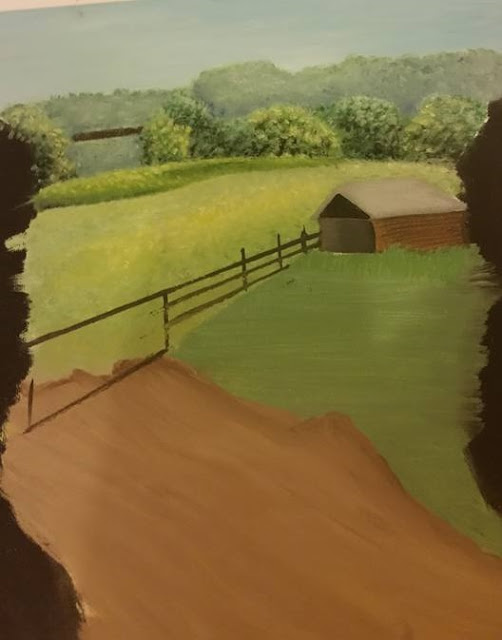



No comments:
Post a Comment